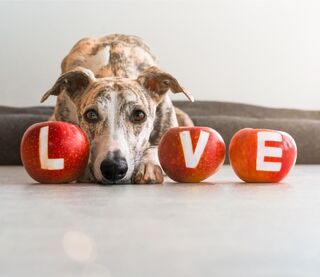Animal Behavior
Why Do We Grieve Losing a Pet So Deeply?
A Personal Perspective: When a pet dies, we lose a cherished companion and more.
Posted November 17, 2022 Reviewed by Vanessa Lancaster
Key points
- Carrying emotional baggage is something we do all the time with people and pets.
- Because pets don't speak, it's easy to project feelings onto them and see the relationship as we most wish it to be.
- When a pet dies, you may uncover the unconscious aspects of the relationship by exploring the nature of your grief.

The depth of our grief when a pet dies can be astonishing. It's common to rely on our pets for more than just companionship and to find in a relationship with a pet what we most need.
It’s natural to read human emotions and thoughts in our pet’s expressions, which is not to diminish human-pet love. In fact, such layering of complexity only adds to our deep attachment. Carrying emotions from one relationship to another happens so instinctively, we don’t notice we’re doing it. It may be only when we find ourselves practically unhinged at our pet’s death that we begin to suspect its extra role in our life. This happened to me.
When our children were six and seven and pleading for a dog, our family adopted a whippet puppy, Artemis, after months of obsessive breed debates. At night, “Temi” roamed from bed to bed, sleeping a while with each of us — we were her pack — but I shared her days and took on her training, her meals, and her visits to the vet. She was the family dog, but I was her mother.
I’d argued for getting a whippet because it’s the largest dog that can fit in a lap, and I dreaded the day the children would get up out of mine for the last time. In fact, as soon as they entered adolescence and their departure was visible on the horizon, I had to put away their baby pictures, which I could no longer bare to see. In time, the children did leave, but Temi stayed.
I adjusted quite well to the empty nest while some of my friends wandered their lonely apartments in tears. But a few years later, when Temi became so ill, we had to help her die; I was the one wandering the neighborhood, tears streaming down my face. My husband and I sat in the bathtub together, a distraction-free space where we talked at day’s end and sobbed. Temi, we suddenly realized, had been filling the two empty spots in our home.
What does science have to say about the human-pet connection?
It's not surprising that pets can become so deeply entwined in our emotional lives. In 2015, Takefumi Kikusui, a Japanese animal behaviorist, published a study that documented the biology supporting our deep connection with dogs. When we gaze into each other’s eyes, both humans and dogs experience a surge in oxytocin, similar to that between humans and infants. We bathe and cuddle our pets, shelter and feed them, and they depend on us completely. No wonder many of us see them as fur babies.
However, this does not mean our pets see us as their parent. Because pets don’t talk, we are free to interpret what they are thinking and to see the relationship as we choose. Our pets will not object to our imbuing them with human traits. If we babble to them, they don’t know it’s baby talk.
What are the roles pets play in our lives?
The options for surrogate roles are infinite. To the youngest daughter, who feels powerless, the pet can be a sibling who lets her be the boss. To a domineering husband, fearful of appearing vulnerable, the pet can be the object of the love he cannot express to his wife. To parents who regret mistakes made with their grown children, the pet can be a second chance. To many of us, the pet is the neglected child in us, finally getting the hugs and approval we’d craved. The bond between a pet and its human is a real interspecies relationship, but it is also more. And when the pet dies, we lose, along with our adored companion, the other profound satisfactions the animal provided.
The human-pet connection is so powerful that even the death of someone else’s pet can touch us to the core. My hairdresser George had a friend with a yappy Shih Tzu named Cleo whom he’d never liked and who he was sure didn’t like him. One day during a visit, the dog jumped up on the couch where George sat, flipping through a magazine. When Cleo tapped a page with her paw, George turned it over, and a duet ensued for the next quarter hour. A few weeks later, George learned that his friend’s dog had died and was stunned to find himself grief-stricken. It seemed that Cleo had come to represent every failed relationship he’d ever written off that might have had a chance.
A few years ago, we faced the final chapter of our second whippet, Baby, whom we had adopted when she was 5 years old after both children had left for good. Having lived with beagles, she initially howled like one when alone but soon settled into the job of being loved. We had many good years together before her health began to decline. First, her hearing went. Then, her arthritis made the stairs a hazard. Her precipitous decline kept me awake at night, replaying the latest evidence of her body giving out.
By this time, I was seeing Baby as my twin, with whom I was facing mortality. At 71, I was keenly aware that my life was finite and that I was actively consuming the time that remained. I hadn't yet experienced any major age-related changes, but I was on the lookout for them while I tracked every tiny change in Baby's health, every tremor, every falter. I peered into her eyes, expecting to see the distress I’d have felt if I were she, but she soldiered on, as dogs do. I had to remind myself continuously that she was aging at seven times my pace. When she became so ill, I couldn’t bare her suffering, and we held her while our vet brought her life to an end. As with the death of Temi, I was swept with guilt at having taken her life and simultaneously relieved that her suffering had ended. “If only we could do this for the humans we love,” I thought. And then, “When the time comes, can my children do this for me?”
When I see a dog, who is joyfully pulling along his human pack, I often think, “There goes a pet with as many guises as there are family members,” the relationship perceived by each member as each needs it to be. Life is complex and often fraught as we struggle in our individual lives and with one another, trying and usually failing to be our best selves. In contrast, our bond with a pet is simple and perfect in a way that no human relationship can be. With pets, we are the ideal parent, teacher, friend, the always-loving, patient person we cannot be in real life. Perhaps along with everything else we lose when a pet dies, is this idealized version of ourselves. Now we must live with our empty arms and laps — and with our diminished selves, as well.
References
Kikusui, T., Nagasawa, M., Mitsui, S., et. al. (2015). Oxytocin-gaze positive loop and the coevolution of human-dog bond. Washington, D.C.: Science.




